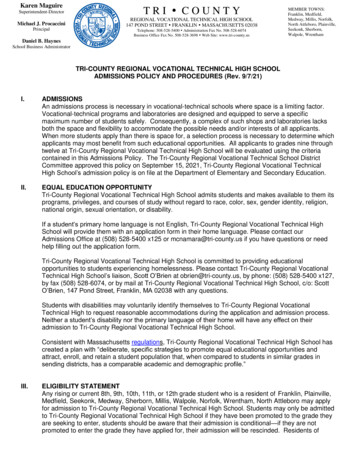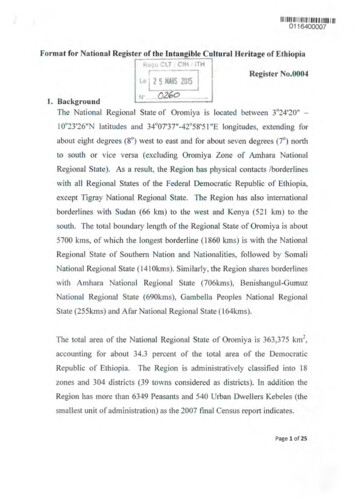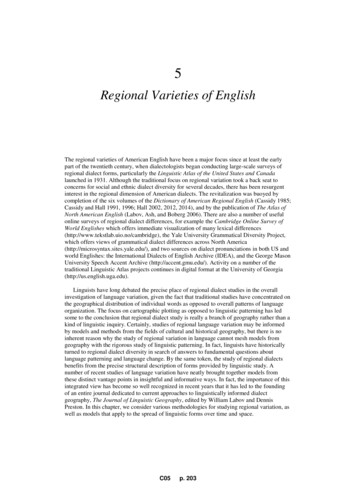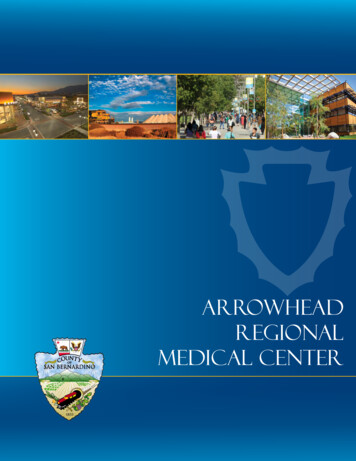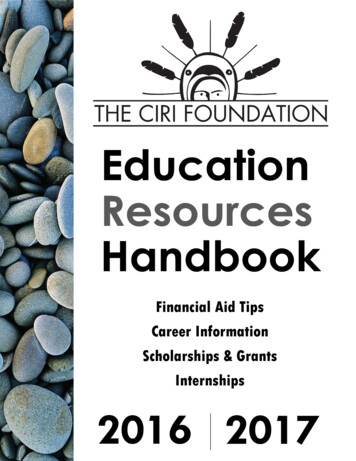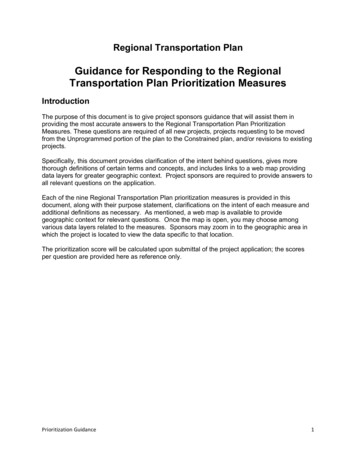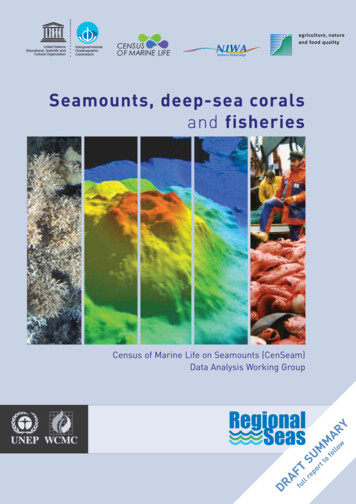
Transcription
United NationsEducational, Scientific andCultural onSeamounts, deep-sea coralsand fisheriesCensus of Marine Life on Seamounts (CenSeam)Data Analysis Working GroupDRAFfuTllreporttoSUMMfollo Aw RYRegionalSeas
Seamounts, deep-sea coralsand fisheriesCensus of Marine Life on Seamounts (CenSeam)Data Analysis Working GroupRegionalSeasDRAFT SUMMARYfull report to follow
Executive summaryhe oceans cover 361 million km2, almost threequarters (71 per cent) of the surface of the Earth. Theoverwhelming majority (95 per cent) of the ocean areais deeper than 130m, and nearly two thirds (64 per cent)are located in areas beyond national jurisdiction. Recentadvances in science and technology have provided anunprecedented insight into the deep-sea, the largest realmon Earth and the final frontier for exploration. Satellite andship-borne remote sensors have charted the seafloor,revealing a complexity of morphological features such astrenches, ridges and seamounts which rival those on land.Submersibles and remotely operated vehicles have documented rich and diverse ecosystems and communities,which have changed how we view life in the oceans.The same advances in technology have also documentedthe increasing footprint of human activities in the remoteand little known waters and seafloor of the deep and highseas. A large number of video observations have not onlydocumented the rich biodiversity of deep-sea ecosystemssuch as cold-water coral reefs, but also gathered evidencethat many of these biological communities had beenimpacted or destroyed by human activities, especially byfishing such as bottom trawling. In light of the concernsraised by the scientific community, the United NationsGeneral Assembly has discussed vulnerable marineecosystems and biodiversity in areas beyond national jurisdiction at its sessions over the last four years (2003-2006),and called, inter alia, ‘for urgent consideration of ways tointegrate and improve, on a scientific basis, the management of risks to the marine biodiversity of seamounts, coldwater coral reefs and certain other underwater features’.This report, produced by the Data Analysis WorkingGroup of the Census of Marine Life programme onSeamounts (CenSeam), is a contribution to the internationalresponse to this call. It reveals, for the first time, the globalscale of the likely vulnerability of habitat-forming stony(scleractinian) corals, and by proxy a diverse assemblage ofother species, to the impacts of trawling on seamounts inareas beyond national jurisdiction. In order to support, focusand guide the ongoing international discussions, and theemerging activities for the conservation and sustainablemanagement of cold-water coral ecosystems on seamounts, the report:1. compiles and/or summarizes data and information onthe global distribution of seamounts, deep-sea corals onseamounts, and deep-water seamount fisheries;2. predicts the global occurrence of environmentalTconditions suitable for stony corals and identifies thegeographic areas where they are most likely to occuron seamounts;3. compares the predicted distribution of stony corals onseamounts with that of deep-water fishing on seamounts worldwide;4. qualitatively assesses the vulnerability of communitiesliving on seamounts to putative impacts by deep-waterfishing activities;5. highlights critical information gaps in the developmentof risk assessments to seamount biota globally.Seamount characteristics and distributionA seamount is an elevation of the seabed with a summit oflimited extent that does not reach the surface. Seamountsare prominent and ubiquitous geological features, whichoccur most commonly in chains or clusters, often along themid-ocean ridges, or arise as isolated features from theseafloor. Generally volcanic in origin, seamounts are oftenconical in shape when young, becoming less regular withgeological time as a result of erosion. Seamounts often havea complex topography of terraces, canyons, pinnacles,crevices and craters: tell-tale signs of the geologicalprocesses which formed them and of the scouring over timeby the currents which flow around and over them.As seamounts protrude into the water column, they aresubject to, and interact with, the water currents surroundingthem. Seamounts can modify major currents, increasing thevelocity of water masses which pass around them. This oftenleads to complex vortices and current patterns which canerode the seamount sediments and expose hard substrate.The effects of seamounts on the surrounding water massescan include the formation of ‘Taylor’ caps or columns,whereby a rotating body of water is retained over the summitof a seamount.In the present study the global position of only largeseamounts ( 1,000m elevation) were taken into account dueto methodological constraints. Based on an analysis of updated satellite data, the location of 14,287 large seamountshas been predicted. This is likely to be an underestimate.Extrapolations from other satellite measurements estimatethat there may be as many as 100,000 large seamountsworld wide.Numbers of predicted seamounts peak between 30ºNand 30ºS with a rapid decline above 50ºN and below 60ºS.The majority of large seamounts (8,955) occur in thePacific Ocean area (63 per cent), with 2,704 (19 per cent) inDRAFT SUMMARYfull report to follow
Executive Summarythe Atlantic Ocean and 1,658 (12 per cent) in the IndianOcean. A small proportion of seamounts are distributedbetween the Southern Ocean (898 – 6 per cent), Mediterranean/Black Seas (59) and Arctic Ocean (13) – bothless than 1 per cent.An analysis of the occurrence of these seamounts insideand outside of Exclusive Economic Zones (EEZs) indicatesthat just over half (52 per cent) of the world’s large seamounts are located beyond areas of national jurisdiction.The majority of these seamounts (10,223 – 72 per cent) havesummits shallower than 3,000m water depth.DEEP-SEA CORALS AND BIODIVERSITYCompared to the surrounding deep-sea environment,seamounts may form biological hotspots with a distinct,abundant and diverse fauna, and sometimes contain manyspecies new to science. The distribution of organisms onseamounts is strongly influenced by the interaction betweenthe seamount topography and currents. The occurrenceof hard substrata means that, in contrast to the mostlysoft sediments of the surrounding deep-sea, seamountcommunities are often dominated by sessile, permanentlyattached organisms that feed on particles of food suspended in the water. Corals are a prominent component ofthe suspension-feeding fauna on many seamounts,accompanied by barnacles, bryozoans, polychaete worms,molluscs, sponges, sea squirts, and crinoids (which includesea lilies and feather stars).Most deep-sea corals belong to the Hexacorallia,including stony corals (scleractinians) and black corals(antipatharians), or the Octocorallia, which include softcorals such as gorgonians.Three dimensional structures rising above the seafloorin the form of reefs created by some species of stony coral,as well as coral ‘beds’ formed by black corals and octocorals, are common features on seamounts and continentalshelves, slopes, banks and ridges. Coral frameworks addhabitat complexity to seamounts and other deep-waterenvironments. They offer refugia for a great variety ofinvertebrates and fish (including commercially importantspecies) within, or in association with, the living and deadcoral framework. Cold-water corals are frequently concentrated in areas of the strongest currents near ridges andpinnacles, providing hard substrata for colonization by otherencrusting organisms and allowing them better access tofood brought by prevailing currents. Although the coexistence between coral and non-coral species is in mostcases still unknown, recent research is showing that somecoral/non-coral relationships may show different levels ofdependency. A review of direct dependencies on coldwater corals globally, including those on seamounts, hasshown that of the 983 coral-associated species studied,114 were characterized as mutually-dependent, of which36 were exclusively dependent to cnidarians (a group ofanimals that contains the corals, hydroids, jellyfishes, andsea anemones). A recent study recorded greater than1,300 species associated with the stony coral Lopheliapertusa on the European continental slope or shelf. Thussome cold-water corals may be regarded as ‘ecosystemengineers’, because they create, modify, and maintainhabitat for other organisms, similar to trees in a forest.Cold-water corals can form a significant component ofthe species diversity on seamounts and play a key ecologicalrole in their biological communities. The assessment of thepotential impacts of bottom trawling on corals is thereforea useful proxy for gauging the effects of these activities onseamount benthic biodiversity as a whole. However acomprehensive assessment of biodiversity is currently impossible because of the lack of data for many faunal groupsliving on seamounts.DISTRIBUTION OF CORALS ON SEAMOUNTSOne of the data sources utilized for this report was adatabase of 3,235 records of known occurrences of fivemajor coral groups found on seamounts, including someshallower features of 1,000m elevation. Existing recordsshow that the stony corals (scleractinians) were the mostdiverse and commonly observed coral group on seamounts(249 species, 1,715 records), followed by Octocorallia (161species, 959 records), Stylasterida (68 species, 374 records),Antipatharia (34 species, 159 records), and Zoanthidea (14species, 28 records). These records included all species ofcorals, including those that were reef-forming, contributedto reef formation, or which occur as isolated colonies.The most evident finding in analysing the coral databaseis that sampling of seamounts has not taken place evenlyacross the world’s oceans and that there are significantgeographic gaps in the distribution of studied seamounts.For some regions, such as the Indian Ocean, very fewseamount samples are available. In total, less than 300seamounts have been sampled for corals, representingonly 2.1 per cent of the identified number of seamountsin the oceans globally (or 0.03 per cent when assumingthere are 100,000 large seamounts). Only a relatively smallnumber of coral species have wide geographic distributionsand very few have near cosmopolitan distributions. Manyof the widely-distributed species are the primary reef,habitat or framework-building stony corals such as Lopheliapertusa, Madrepora oculata and Solenosmilia variabilis.In most parts of the world, stony corals were themost diverse group, followed by the octocorals. However, inthe northeastern Pacific, octocorals are markedly morediverse than stony corals. Most stony corals and stylasteridspecies occur in the upper 1,000-1,500m depth range.DRAFT SUMMARYfull report to follow3
Seamounts, deep-sea corals and fisheriesAntipatharians also occurred in the upper 1,000m, althougha higher proportion of species occur in deeper waters thanthe two previous groups. Octocorals were distributed togreater depths, with most species in the upper 2,000m. Verylittle sampling has occurred below 2,000m.There are a number of reasons for the differences in thedepth and regional distribution of the coral groups, includingspecies-related preferences of the nature of substratesavailable for attachment, quantity and abundance of food atdifferent depths, the depth of the aragonite saturationhorizon, temperature, and the availability of essentialelements and nutrients.PREDICTING GLOBAL DISTRIBUTION OF STONY CORALSON SEAMOUNTSThe dataset for corals on seamounts revealed significantareas of weakness in our knowledge of coral diversity anddistribution on seamounts, especially the lack of samplingon seamounts at equatorial latitudes. Thus, to make areasonable assessment of the vulnerability of corals onseamounts to bottom trawling (and, by proxy, determinethe potential impacts of this activity on non-coralassemblages), it was necessary to fill the sampling gapsby predicting the global occurrence of suitable coralhabitat by modelling coral distribution.An ‘environmental niche factor analysis’ (ENFA) wasused to model the global distribution of deep-sea stonycorals on seamounts and to predict habitat suitability forunsampled regions. Other groups of coral such as octocorals, for example, can also form important habitats suchas coral beds. These corals may have very different distributions to stony corals, which would also be useful toappreciate in the context of determining the vulnerability ofseamounts communities to bottom trawling. Unfortunately,the available data for octocorals are currently too limited toenable appropriate modelling.ENFA compares the observed distribution of a species tothe background distribution of a variety of environmentalfactors. In this way, the model assesses the environmentalniche of a taxonomic group, i.e. how narrow or wide thisniche is, identifies the relative difference between the nicheand the mean background environment, and reveals thoseenvironmental factors that are important in determining thedistribution of the studied group.The model used and combined:1. the location data of 14,287 predicted large seamounts;2. the location records of stony corals (scleractinia) onseamounts;3. physical, biological, and chemical oceanographic datafrom a variety of sources for 12 environmental parameters (temperature; salinity; depth of coral occurrence;4surface chlorophyll; dissolved oxygen; percentage ofoxygen saturation; overlying water productivity; exportprimary productivity; regional current velocity; totalalkalinity; total dissolved inorganic carbon; aragonitesaturation state).The model predictions were as follows: in near-surfacewaters (0-250m) habitat predicted to be suitable for stonycorals lies in the southern North Atlantic, the SouthAtlantic, much of the Pacific, and the southern IndianOcean. The Southern Ocean and the northern NorthAtlantic are, however, unsuitable. Below 250m depth,the suitability patterns for coral habitat changesubstantially. In depths from 250m-750m, a narrow bandoccurs around 30ºN 10º and a broader band of suitablehabitat occurs around 40ºS 20º. In depths from 750m1,250m, the North Pacific and northern Indian Ocean areunsuitable for stony corals. The circum-global band ofsuitable habitat at around 40ºS 10º narrows with depth(to 10º). Suitable habitat areas also occur in the NorthAtlantic and tropical West Atlantic. These areas remainsuitable for stony corals with increasing depth (1,250m1,750m; 1,750m-2,250m; 2,250m-2,500m), whereas theband at 40ºS breaks up into smaller suitable habitat areasaround the southeast coast of South America and the tip ofSouth Africa.The global extent of habitat suitability for seamountstony corals was predicted to be at its maximum betweenaround 250m and 750m. The majority of the suitablehabitat for stony corals on seamounts occurs in areasbeyond national jurisdiction. However, suitable habitatsare also predicted in deeper waters under nationaljurisdiction, especially in the EEZs of countries:1. between 20ºS and 60ºS off Southern Africa, SouthAmerica and in the Australia/New Zealand region;2. off north-west Africa; and3. around 30ºN in the Caribbean.Combining the predicted habitat suitability with thesummit depth of predicted seamounts indicates that themajority of seamounts that may provide suitable habitaton their summit for stony corals are located in the AtlanticOcean. The rest are mostly clustered in a band between 15ºSand 50ºS. A few seamounts elsewhere, such as in the SouthPacific, with summits in the depth range between 0m and250m are highly suitable. In the Atlantic, a large proportionof suitable seamount summit habitat is beyond nationaljurisdiction, whereas in the Pacific most of this seamounthabitat lies within EEZs. In the southern Indian Ocean,suitable habitat appears both within and outside of EEZs.When analysing the habitat suitability on the basis of summitdepth, it should be noted that suitable habitat for stonyDRAFT SUMMARYfull report to follow
Executive Summarycorals might also occur on the slopes of seamounts, i.e. atdepths greater than the summit.The analysis found the following environmental factorswere important for determining suitable habitat for stonycorals: high levels of aragonite saturation, dissolved oxygen,percentage of oxygen saturation, and low values oftotal dissolved inorganic carbon. Neither surface chlorophyll, nor regional current velocity, appear to be importantfor the global distribution of stony corals on seamounts.Nevertheless, these factors may be important for thedistribution of corals at smaller spatial scales, such as on anindividual seamount.The strong dependency of coral distribution on theavailability of aragonite – a form of calcium carbonate – isnoteworthy. Stony corals use aragonite to form their hardskeletons. A reduction in the availability of aragonite, forexample through anthropogenic induced acidification of theoceans through rising CO2 levels, will limit the amount ofsuitable habitat for stony corals.SEAMOUNT FISH AND FISHERIESSeamounts support a large and diverse fish fauna. Recentreviews indicate that up to 798 species are found on andaround seamounts. Most of these fish species are notexclusive to seamounts, and occur widely on continentalshelf and slope habitats. Seamounts can be an importanthabitat for commercially valuable species which may formdense aggregations for spawning or feeding, which aretargeted by large-scale fisheries.For the purpose of this report, the distribution and depthranges of commercial fish species were compiled from anumber of internet and literature sources, includingseamount fisheries catch data of Soviet, Russian andUkrainian operations since the 1960s; published data onJapanese, New Zealand, Australian, EU and southernAfrican fisheries; FAO catch statistics; and unpublishedsources. Although known to be incomplete, this is themost comprehensive compilation attempted to date for seamount fisheries, and is believed to give a reasonable indication of the general distribution of seamount catch over thelast four decades.Deep-water trawl fisheries occur in areas beyondnational jurisdiction for around 20 major species. Theseinclude alfonsino (Beryx splendens), black cardinalfish(Epigonus telescopus), orange roughy (Hoplostethusatlanticus), armourhead and southern boarfish(Pseudopentaceros spp.), redfishes (Sebastes spp.),macrourid rattails (primarily roundnose grenadierCoryphaenoides rupestris), oreos (including smooth oreoPseudocyttus maculatus, black oreo Allocyttus niger) andPatagonian toothfish (Dissostichus eleginoides and in someareas Antarctic toothfish D. mawsoni), which has a restrictedsouthern distribution. Many of these fisheries use bottomtrawl gear. Other fisheries occur over seamounts, such asthose for pelagic species (mainly tunas) and target speciesfor smaller scale line fisheries (e.g. black scabbardfishAphanopus carbo).The distribution of four of the most importantseamount fish species (for either their abundance orcommercial value) are as follows:1. ORANGE ROUGHY is widely distributed throughout theNorth and South Atlantic Oceans, the mid-southernIndian Ocean, and the South Pacific: it does not extendinto the North Pacific. It is frequently associated withseamounts for spawning or feeding, although it is alsowidespread over the general continental slope.2. ALFONSINO has a global distribution, being found in allthe major oceans. It is a shallower species than orangeroughy, occurring mainly at depths of 400m to 600m. Itis associated with seamount and bank habitat.3. ROUNDNOSE GRENADIER is restricted to the NorthAtlantic, where it occurs on both sides, as well as onthe Mid-Atlantic Ridge, where aggregations occur overpeaks of the ridge.4. PATAGONIAN TOOTHFISH has a very wide depth rangeand is sometimes associated with seamounts, but alsofound on general slope and large bank features.The distribution of historical seamount fisheries includesheavy fishing on seamounts in the North Pacific Oceanaround Hawaii for armourhead and alfonsino; in the SouthPacific for alfonsino, orange roughy, and oreos; in thesouthern Indian Ocean for orange roughy and alfonsino;in the North Atlantic for roundnose grenadier, alfonsino,orange roughy, redfish, and cardinalfish; and in the SouthAtlantic for alfonsino and orange roughy. Antarctic watershave been fished for toothfish, icefish, and notothenid cods.The total historical catch from seamounts has beenestimated at over 2 million tonnes. Many seamount fishstocks have been overexploited and without proper andsustainable management, followed a ‘boom and bust’cycle. After very high initial catches per unit effort,the stocks were depleted rapidly over short time scales( 5 years) and are now closed to fishing or no longersupport commercial fisheries. The life history characteristics of many deep water fish species (e.g. slow growthrate, late age of sexual maturity) make the recovery andre-colonization of previously fished seamounts slow.Over the last decade, exploratory fishing for deepwater species in many areas beyond national jurisdiction has focussed on alfonsino and orange roughy. Thedepth distribution of the two main target fisheries foralfonsino and orange roughy differ. The former isprimarily fished between 250m and 750m, and includesDRAFT SUMMARYfull report to follow5
Seamounts, deep-sea corals and fisheriesassociated commercial species like black cardinalfish andsouthern boarfish. The orange roughy fisheries on seamounts, between 750 and 1,250m depth (deeper fishingcan occur on the continental slope), include black andsmooth oreos as bycatch. Seamount summit depth datawas used to indicate where such suitable fisheries habitatmay occur in areas beyond national jurisdiction. Combinedwith information on the geographical distribution of thecommercial species, various areas where fishing couldoccur were broadly identified. Many of these areas are inthe southern Indian Ocean, South Atlantic, and NorthAtlantic. The South Pacific Ocean also has a number ofridge structures with seamounts that could host stocksof alfonsino and orange roughy. Many of these areashave already been fished and some are known to havealready been explored, but commercial fisheries havenot developed.ASSESSING THE VULNERABILITY OF STONY CORALECOSYSTEMS ON SEAMOUNTSIn order to assess the likely vulnerability of corals and thebiodiversity of benthic animals on seamounts to the impactof fishing, the report examines the overlap and interactionbetween:1. the predicted global distribution of suitable habitat forstony (scleractinian) corals;2. the location of predicted large seamounts with summitsin depth ranges of the alfonsino and orange roughyfishery; and3. the distribution of the fishing activity on seamounts forthese two species, and combines this with informationon the known effects of trawling.Many long-lived epibenthic animals such as corals havean important structural role within seafloor communities,providing essential habitat for a large number of species.Consequently, the loss of such animals lowers survivorship and re-colonization of the associated fauna, and hasspawned analogies with forest clear-felling on land. Aconsiderable body of evidence on the ecological impactsof trawling is available for shallow waters, but scientificinformation on the effects of fishing on deep-sea seamountecosystems is much more limited to studies from seas offnorthern Europe, Australia, and New Zealand. These studiessuggested that trawling had largely removed the habitatand ecosystem formed by the corals, and thereby negativelyaffected the diversity, abundance, biomass and compositionof the overall benthic invertebrate community.The intensity of trawling on seamounts can be very high.Hundreds to several thousand trawls have been carriedout on small seamount features in the orange roughyfisheries around Australia and New Zealand. Such intense6fishing means that the same area of the seafloor can berepeatedly trawled, causing long-term damage to the coralcommunities by preventing any significant recovery orrecolonization. The impact of trawling on the seafloor biotadiffers depending on the gear type used. The most severedamage has been reported from the use of bottom trawls inthe orange roughy fisheries on seamounts. Informationabout the potential impact of trawling practices foralfonsino, where midwater trawls are often used on seamounts, is currently lacking. Midwater trawls may have onlya small impact if they are deployed well above the seafloor.However, in many cases the gear is most effective whenfished very close to, or even lightly touching, the bottom.Thus, it is likely that the effects of the alfonsino fisheries onthe benthic fauna would be similar to that of the orangeroughy fisheries.The comparison between the distributions ofcommercially exploited fish, fishing effort and coralhabitat on seamounts highlighted a broad band of thesouthern Atlantic, Pacific and Indian Oceans betweenabout 30 S and 50 S, where there are numerousseamounts at fishable depths, and high habitat suitabilityfor corals at depths between 250m and 750m (thepreferred alfonsino fisheries depth range), and again – butsomewhat narrower – between 750m and 1,250m depth(the preferred orange roughy fisheries depth range).This spatial concordance suggests there could befurther commercial exploration for alfonsino and orangeroughy fisheries on large seamounts in the centraleastern Southern Indian Ocean, the southern portions ofthe Mid-Atlantic Ridge in the South Atlantic, and someregions of the southern-central Pacific Ocean. Importantly,since these areas also contain habitat suitable for stonycoral, impacts on deep-water corals and seamountecosystems in general are likely to arise in such ascenario. However, it is uncertain whether fisheriesexploration will result in economic fisheries.A WAY FORWARDThis report has identified sizeable geographical areas withlarge seamounts, which are suitable for stony corals andwhich are vulnerable to the impacts of expanding deep-seafishing activities. To establish and implement adequate andeffective management plans and protection measures forthese areas beyond national jurisdiction will present majorchallenges for international cooperation. In addition, thereport identified that there are large gaps in the currentknowledge of the distribution of seamounts and the biodiversity which they harbour.In the light of these findings, the report recommends anumber of activities to be carried out in a collaborativeDRAFT SUMMARYfull report to follow
Executive Summaryapproach between all stakeholders under the followingheadings:How can the impacts of fishing on seamounts be managedin areas beyond national jurisdiction?Management initiatives for seamount fisheries withinnational EEZs have increased in recent years. Severalcountries have closed seamounts to fisheries, establishedhabitat exclusion areas, and stipulated method restrictions,depth limits, individual seamount catch quotas, and bycatchquotas.In comparison, fisheries beyond areas of nationaljurisdiction have often been entirely unregulated. Thereare 12 Regional Fisheries Management Organizations(RFMOs) with responsibility to agree on binding measuresthat cover areas beyond national jurisdiction, includingsome of the geographical areas identified in this reportthat might see further expansion of exploratory fishingfor alfonsino and orange roughy on seamounts. A RMFOcovers parts of the eastern South Atlantic whereexploratory fishing has occurred in recent decades, andwhere further trawling could occur. However, the westernside of the South Atlantic is not similarly covered by aninternational management organization. There have beenrecent efforts to improve cooperative management offisheries in the Indian Ocean, although there are no areascovered by an RMFO. In addition, efforts are underway, forexample in the South Pacific, to establish a new regionalfisheries convention and body which would fill a large gapin global fisheries management. However, it should benoted that only the five RFMOs for the Southern Ocean,Northwest Atlantic, Northeast Atlantic, Southeast Atlanticand the Mediterranean currently have the legal competenceto manage most or all fisheries resources within their areasof application, including the management of deep-seastocks beyond national jurisdiction. The other RFMOs havecompetence only with respect to particular target specieslike tuna or salmon.In the light of the recent international dialoguesconcerning the conservation and sustainable managementand use of biodiversity in areas beyond national jurisdictionheld within and outside the United Nations system, variousfisheries bodies are becoming more active to up-date theirmandates and to include benthic protection measures aspart of their fisheries management portfolio. It appears thata growing legislation and policy framework, including anexpanding RFMO network in particular in the southernhemisphere, could enable the adequate protection andmanagement of the risks to vulnerable seamount ecosystems and resources identified in this report. In order tobe successful, a number of challenges will have to beovercome, including:1. Establishing adequate data reporting requirementsfor commercial fishing fleets. Some unregulated andunreported fishing activities take place, even in areaswhere there are well defined fishery codes of practiceand allowable catch limits (e.g. Patagonian toothfishfishery). Some countries require vessels registered tothem to report detailed catch and effort data, but manydo not. Therefore it is difficult at times to know wherecertain landings have been taken.2. Ensuring compliance with measures, especially inareas that are far offshore and where vessels aredifficult to detect. Compliance monitoring is also acu
Email: info@unep-wcmc.org Website: www.unep-wcmc.org www.unep.org United Nations Environment Programme P.O. Box 30552, Nairobi, Kenya Tel: 254 (0) 20 7621234 Fax: 254 (0) 20 7623927 Email: uneppub@unep.org Website: www.unep.org October 2006 UNEP Regional Seas Report and Studies No 183 UNEP-WCMC Biodiversity Series No 25 DRAFT SUMMARY w



